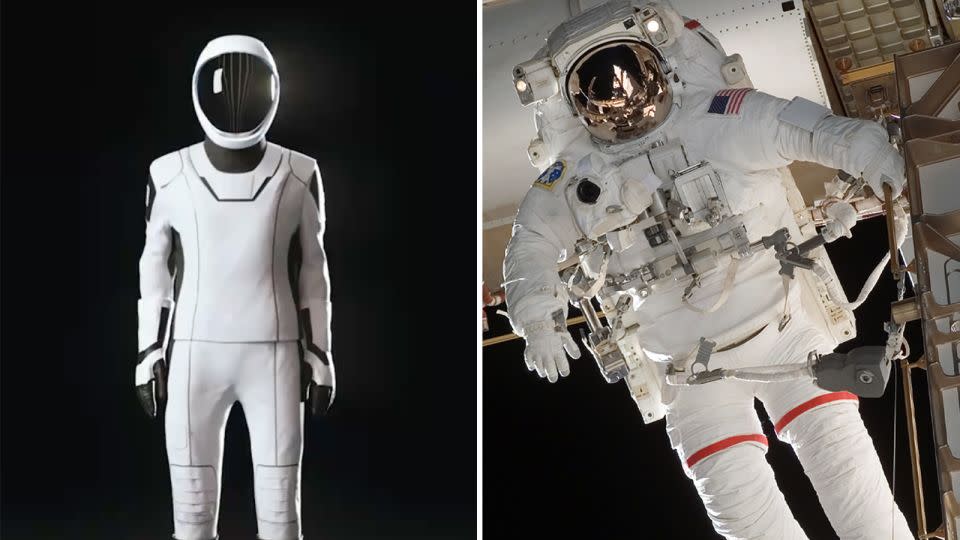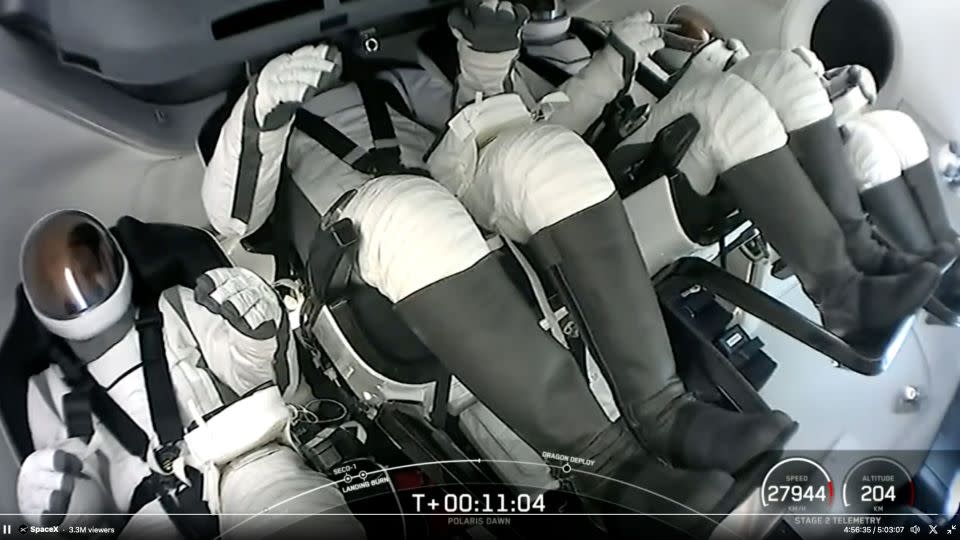SpaceX’s Polaris Dawn mission kicked off early Tuesday, launching a four-person crew of civilian astronauts into orbit. And hours later they have already made history: reaching the highest orbit around Earth and surpassing a record set during NASA’s earliest days.
The company confirmed that the SpaceX Crew Dragon spacecraft carrying the crew reached its peak altitude of 1,400.7 kilometers (870 miles) at 9:19 p.m. ET on Tuesday.
That distance surpassed the record set by NASA’s 1966 Gemini 11 mission, which reached 853 miles (1,373 kilometers) during its trek around Earth.
NASA’s Apollo missions traveled farther but did not enter a traditional orbit around Earth. They were destined for the moon, which lies a quarter million miles away from our planet. The Polaris Dawn mission also marks the farthest any human has journeyed since the final Apollo mission in 1972 — and the farthest into space a woman has ever traveled.
An unprecedented spacewalk
SpaceX and the Polaris Dawn crew may be celebrating their milestone, but the riskiest endeavors are still ahead for this five-day mission — which is designed to push the limits of commercial space travel and help test out technologies that SpaceX may use on excursions deeper into the cosmos.
As soon as Thursday morning, the Polaris Dawn team — which includes Shift4 Payments CEO Jared Isaacman, the financer of the mission; his close friend and former US Air Force pilot Scott “Kidd” Poteet; and SpaceX engineers Anna Menon and Sarah Gillis — will attempt to conduct the first commercial spacewalk.
The groundbreaking event, set to kick off early on the crew’s third day in space, is expected to take place while the crew is orbiting about 435 miles (700 kilometers) above Earth.
Isaacman, Menon, Poteet and Gillis will be exposed to the vacuum of space as their Crew Dragon capsule is depressurized and a circular hatch is opened. And two crew members, Gillis and Isaacman, will exit the spacecraft during the roughly two hours that the vehicle is left with an open doorway into the vast expanse.
The crew will be shielded from the unforgiving void only by SpaceX’s new Extravehicular Activity — or EVA — suits. The spacesuits were designed and developed in 2 ½ years, which is incredibly quick by aerospace standards.
In comparison, NASA has been trying for well over a decade to secure replacements for the aging spacesuits aboard the International Space Station. Those suits were designed 40 years ago.


Astronauts Rick Mastracchio and Canadian Space Agency’s Dave Williams (out of frame), both STS-118 mission specialists, participate in the mission’s first planned session of extravehicular activity (EVA), as construction continues on the International Space Station August 11, 2007. – SpaceX/NASA
The Crew Dragon capsule is already putting the crew through a lengthy “pre-breathe” process, which prepares the astronauts’ bodies for the spacewalk. It works by slowly purging nitrogen from the crew members’ blood so that the gas does not bubble up in their bloodstream as the pressure changes inside the vehicle.
The pre-breathe process aims to avoid decompression sickness — the same dangerous and potentially fatal illness that scuba divers may face if they attempt to surface too quickly.
The pre-breathe protocol the Polaris Dawn crew is undergoing is entirely unlike what is carried out on the International Space Station. The space station has special air locks where astronauts can undergo a rapid pre-breathing process before beginning their spacewalks. It takes only a couple of hours.
The Polaris Dawn crew’s pre-breathe routine, however, will last about 45 hours, Gillis told CNN, as the oxygen content in the cabin slowly increases while the pressure decreases.


“What is really cool about this (pre-breathing) profile is it actually, in many ways, is much less risky than what the standard is on the space station,” Gillis told CNN. “It’s like opening a can of soda pop — and you want to open the can (and have) none of the bubbles to come out because the pressure outside of the can is equal to what’s inside.”
By lowering the pressure inside Crew Dragon, Gillis said, and putting on their spacesuits just as the ambient pressure equals the suit pressure — the crew members can better mitigate any risk of unwanted bubbles.
The biggest challenge comes after the spacewalk concludes: closing the hatch on board the Crew Dragon capsule, getting pressurization to back to normal and safely returning to Earth.
“You should be nervous about (this mission),” former NASA astronaut and SpaceX adviser Garrett Reisman told CNN in August. “Anytime you try something for the first time there are significant risks. I’ll feel much better when they are back inside with the hatch closed and latched.”
For more CNN news and newsletters create an account at CNN.com
